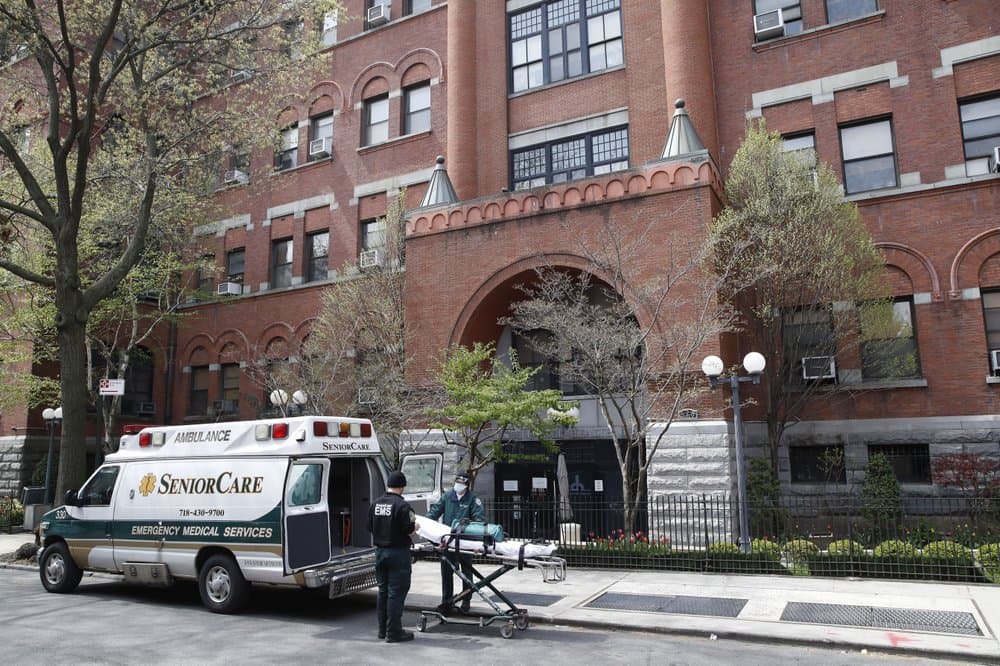[Editor’s Note: Since 2006, Thomas Blonski has been president and chief executive officer of Catholic Charities New Hampshire, one of the state’s largest social services organizations. Under his leadership, Catholic Charities New Hampshire expanded its healthcare services for elderly across the state and acquired The CareGivers Inc. and Monadnock at Home, which provide transportation services and food delivery for homebound seniors and the disabled. Blonski currently serves on the New Hampshire Supreme Court’s Character and Fitness Committee, the Manchester Chamber of Commerce Board. He spoke to Charles Camosy about the ongoing COVID-19 pandemic, and it’s disproportionate effect on care facilities.]
Camosy: New Hampshire has had a very high percentage of COVID-related deaths in nursing homes and other long-term care facilities — I think somewhere around 70 percent, right? Several other states are in this range too, and I recently learned from a Politico article that in Canada it is 80 percent. Why do you think so much of the death from the pandemic has been found in nursing homes?
Blonski: For context, nursing homes are the second most regulated industry in the US, next to the nuclear industry.
Infection control is regularly monitored and scrutinized because we’re dealing with very sick residents. Even seemingly minor transgressions can end up as a state/federal “finding/deficiency” that must be immediately corrected. It requires a lot of follow-up, vigilance, education and support. These regulations are in place because residents in nursing homes are typically in their frailest state and most vulnerable.
In New Hampshire, the average age of a nursing home resident is in their upper-80s; most suffer from many significant health ailments and/or some form of dementia. Because of this, their immune systems are very weak and they are susceptible to many diseases, viruses and illnesses.
COVID-19 is an invisible enemy that we’re still learning about and seeing changes with every day. Because of the asymptomatic nature of the virus, and how easily/rapidly it spreads – even with extremely rigid infection control protocols in place – you can be doing everything right (according to CDC, CMS and DHHS guidelines) and still have the virus introduced into your facility. That being said, in light of the persistent negative press around nursing homes, for perspective, deaths in long-term care facilities from the flu equate to about 80,000 people in the US every year.
In New Hampshire, deaths from COVID-19 account for 1 percent of our licensed beds, versus 5.6 percent in Massachusetts; 5 percent Rhode Island and 3.2 percent in Connecticut. Despite this, even one death is too many.
I understand that the six nursing homes in New Hampshire run by Catholic Charities have been much better and much safer than others in your state during the pandemic. Do you have a sense of why that is?
When the pandemic first hit in early March, Catholic Charities New Hampshire took immediate precautions to safeguard our residents and staff. We started daily staff meetings to discuss when (not if) the virus would hit and how we needed to prepare. We reinforced our rigid infection control policies and procedures, restricted our facilities from visitors, started daily screenings of all employees before they entered our buildings and required staff to only work at one facility, not multiple ones. Nursing homes across the country have followed this same protocol. (As an aside, our staffing ratios have always been generally higher than for-profit facilities.)
We also enhanced our recreational activities with more one-on-one resident visits to address isolation and facilitated residents’ ability to better communicate with their families through online forums (via tablets) and coordinated family car parades for Easter, Mother’s Day, National Nurses Week, and National Nursing Home Week using safe social distancing. Additionally, we worked feverishly to procure appropriate, quality and reasonably-priced personal protective equipment (masks, gloves, goggles, face shields, isolation gowns, etc.) for staff. This has been a full-time job trying to secure these products, in light of the fact that some of our pre-paid product(s) ended up in quarantine at customs (China or U.S.), confiscated by our government and/or waylaid in various parts of the country and world – for unknown reasons.
Despite significant delays, we prevailed, by working with multiple vendors (including our state) to get sufficient product on a timely basis. Our diligence paid off; in addition to having full isolation gear available to our staff for protection, we also provided them with three masks per day when some other facilities (earlier on in the pandemic) were only able to provide one mask per week. We also give staff masks to take home to use for themselves and their families for additional safety.
Despite all of this, one of the most important components of trying to stay on top of a pandemic that continues to change hour-by-hour, day-by-day, is to continuously remind and educate staff to follow CDC protocol(s) regarding handwashing, donning masks and social distancing. This is a very hard variable to control when staff are not working in the facility. And when you have a large amount of the general public not following these guidelines, it’s only a matter of time before one of our staff comes into contact with an asymptomatic/symptomatic carrier. We’ll need regular, weekly COVID testing for all staff and a percentage of our residents in order to be able to get ahead of this and better mitigate risk.
Is this something that is true of other nursing homes run by Catholic Charities around the country? Do you think an intentional Catholic mission and identity makes a difference?
I am unaware of the specifics of how other Catholic Charities’ nursing homes are run, although I know we share common values as the human/social service arm of the church in honoring the dignity of life, the dignity of the person, subsidiarity and solidarity. We are collectively driven by compassion and the belief that every person we encounter is sacred and has dignity and worth. There’s also the sense that when others give up, we don’t. And that the work that we do is not motivated by compulsion or obligation or profit; it is motivated by love. For that, we are honored and grateful to be able to do the work that we do!
The Politico article revealed that many of the long-term care facilities in Canada are in terrible condition. If we believe the numbers done on care homes in the U.S., there are a high percentage here with deep problems as well. What do you think children and other who love their elderly family members should be thinking about when they consider long term care?
When considering long-term care placement for a loved one, I would encourage a family member to do their homework and to be extremely engaged in the care process (planning and implementation) throughout the resident’s length of stay in the nursing home. Once visitor restrictions are lifted, they should show up to the nursing home unannounced and ask for a tour with one of the supervisors. This will give them a sense of the environment and staff/resident interactions.
They should also ask to see the most recent state and or federal surveys/inspection (done at least annually) to determine compliance or areas that need improvement. Finally, the best care a resident receives in a facility is when a family member(s) is fully engaged, realistic about care expectations, honest, regularly communicative, and collaborates effectively with the care team at the nursing home. There is a direct correlation between appropriate family involvement and great resident care. When this doesn’t happen or concerns/complaints don’t get immediately addressed (so they can be corrected right away), things can sometimes go awry.
Also, families should educate themselves about whom to contact should an issue remain unresolved. Start by discussing your grievance with the Director of Nursing, then the administrator or CEO. If things aren’t corrected, a state ombudsman or the State Department of Health and Human services can be contacted to file a complaint.
What about long-term reform from the government? Are there social-structural issues with care of our elderly and disabled that a “Phase Four” pandemic bill – or perhaps a major infrastructure bill – could address? What might you suggest?
Again, for context, from a resident and staff perspective, the devastating impact of this virus on seniors has created unprecedented fear and anxiety for nursing homes and the staff who come to work every day while garbed in uncomfortable PPE their entire shift and literally risking their own health to do so.
While staff who work in hospitals are praised for doing the very same thing, nursing home employees are barraged almost daily with negative press related to nursing homes; this is disheartening and demoralizing. Most often, people who work in nursing homes stumble upon this career and quickly fall in love with caring for the elderly, whether giving comfort and quality care at the end of life, or assisting a short-term resident to rehabilitate and return home. And they stay because of the personal satisfaction that comes with building relationships with the elders they serve.
Collectively, as a culture, we all have a responsibility to care for our seniors. We need to come from a place of collaboration where government, communities and individuals come together to find a solution for sustainable senior care. Along those lines, long-term reform needs more thought leaders to offer insightful, creative solutions, not people/media who continue to bash the industry with harmful/hateful stories; that’s not helpful and/or forward thinking. It keeps us stagnant. Yes, egregious providers should be called out, but all nursing homes shouldn’t be cast in the same light.
Finally, as a society, we do not value our seniors like we value youth or job titles. It’s as if they have an unwritten “expired by” date on their foreheads, after which they get cast aside and rendered useless. The way we value them is also reflected in the amount of funding we set aside for their care to adequately meet their needs. New Hampshire, for example, is at the bottom of the heap for nursing home funding for our Medicaid residents. On average, we lose about $45/resident per day for every Medicaid resident for whom we care. To balance this, we have to have a specific number of Medicare and private pay residents to stay afloat; the three payors are referred to as our payor mix. And while diligently managing this payor mix, day-by-day, this only contributes to a 1-2 percent margin on any given year if we’re lucky.
If we want long-term care reform, it’ll be expensive. Physical plants are old; they need to be updated or torn down and rebuilt. We need more private rooms and/or smaller clusters of multiple “pods” (where fewer residents live in each pod) to mitigate the spread of future infections. We need to pay line staff (who provide the most difficult care) livable wages to better compete with retail who offer better wages with less stress/fewer responsibilities and provide more moral support, as a society, so staff feel valued in their job(s).















